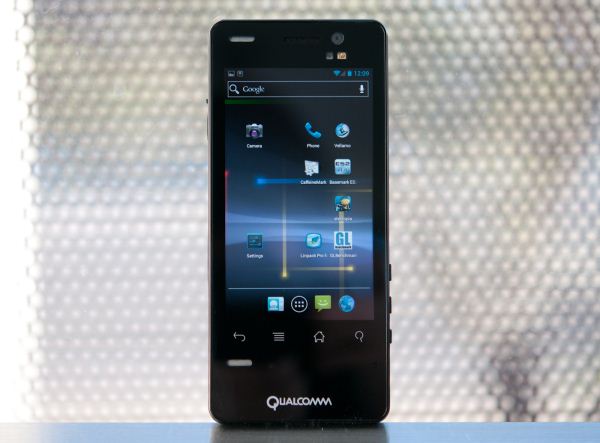Qualcomm Snapdragon S4 (Krait) Performance Preview - 1.5 GHz MSM8960 MDP and Adreno 225 Benchmarks
by Brian Klug & Anand Lal Shimpi on February 21, 2012 3:01 AM EST- Posted in
- Smartphones
- Snapdragon
- Qualcomm
- Adreno
- Krait
- Mobile
Final Words
It goes without saying that MSM8960 is a hugely important SoC release for Qualcomm. It's the first release with Qualcomm's new Krait CPU architecture, an entirely new cellular baseband with support for nearly every air interface, and is manufactured on TSMC's 28nm process. It says something that we're able to hold 28nm TSMC silicon in our hands in the form of the MDP, and it's only a matter of time before we start seeing Krait show up in devices in 2012.
We've gone over basically all of the benchmarks available to us on Android right now, and yet subjective performance impressions are still valuable. The MDP8960 is the absolute fastest we've seen Ice Cream Sandwich thus far - the UI is absolutely butter smooth everywhere, and web browsing in either Chrome or the stock Android Browser is also the smoothest we've seen it. There's no stutter bringing up the application switcher, or taking screenshots, two places that 4.0.3 still drops frames on the Galaxy Nexus.
Krait offers another generational leap in mobile SoC performance. The range of impact depends entirely on the workload but it's safe to say that it's noticeable. The GPU side of the equation has been improved tremendously as well, although that's mostly a function of 28nm enabling a very high clock speed for Qualcomm's Adreno 225. We are eager to see what the Adreno 3xx GPUs that will pair up with future Krait SoCs can do.
The big unknowns today are power consumption and the performance of shipping devices. While we were able to provide power numbers using Qualcomm's handy Trepn tool, we couldn't produce a reference point on older silicon. The move to 28nm and a second generation of cellular basebands has generally been heralded as being the answer to our battery life issues, particularly with LTE. It remains to be seen just how much of an improvement we'll see there. Knowing how much power MSM8960's cellular architecture uses is especially relevant when you consider that MDM9615 includes the exact same modem as MSM8960.
These initial results look extremely promising, however. Krait based devices should begin shipping sometime next quarter, the wait is almost over.











86 Comments
View All Comments
sciwizam - Tuesday, February 21, 2012 - link
Any thoughts on how Krait will compare against the A15 chips and when's the earliest will those be on market?wapz - Tuesday, February 21, 2012 - link
Look in the architecture article on page 1 here: http://www.anandtech.com/show/4940/qualcomm-new-sn..."ARM hasn't published DMIPS/MHz numbers for the Cortex A15, although rumors place its performance around 3.5 DMIPS/MHz."
Krait has 3.3 DMIPS/MHz, so if a dual Cortex A15 would run at the same frequency they would be fairly comparable I would imagine (obviously ignoring all other elements that could help performance on either of them).
wapz - Tuesday, February 21, 2012 - link
And if that's the case, HTC will have an interesting problem with their new lineup. It would mean, if the rumours are correct, their new flagship One X model using Tegra3 AP33 chipset at 1,5GHz and a 4,7 inch 720p screen might be slower compared to the One S, sporting the Snapdragon S4 chipset and a 4,3 inch screen with qHD.Lucian Armasu - Tuesday, February 21, 2012 - link
In that case even if the GPU's were equal in performance, the One S would be faster due to the fact that it uses a lower resolution.zorxd - Tuesday, February 21, 2012 - link
If by "faster", you mean more FPS in a 3D game, then yes.The resulting image quality would be lower however.
metafor - Tuesday, February 21, 2012 - link
Yes. FPS is only one factor in the overall equation of user experience. Higher resolution rendering is definitely preferable assuming one could maintain ~60fps.zorxd - Tuesday, February 21, 2012 - link
I'd rather have a 34 fps 1280x720 than a 60 fps 960x540.sosrandom - Tuesday, February 21, 2012 - link
or better graphics at 30fps @ 960x540 than 30fps @ 1280x720trob6969 - Wednesday, February 22, 2012 - link
I agree, i would take quality over speed any day as long as the difference in speed is measured in mere seconds.vol7ron - Thursday, March 1, 2012 - link
I can't wait to see the power savings, especially since the modem is a huge power draw, and one of the benefits is that QC is the manufacturer, which means integrated chip and less power consumption (as well as thinner device).